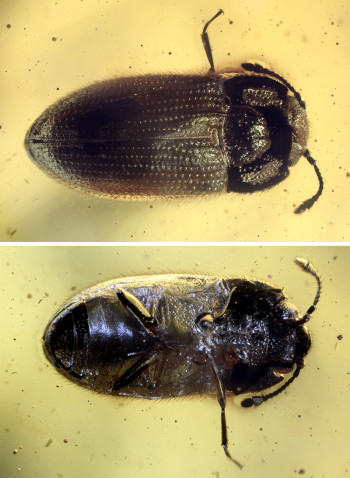 A new fossil species of biphyllid beetles, Biphyllus lar Alekseev, Bukejs et Vitali, from Baltic amber (storage location: Kaliningrad Amber Museum).
A new fossil species of biphyllid beetles, Biphyllus lar Alekseev, Bukejs et Vitali, from Baltic amber (storage location: Kaliningrad Amber Museum).An employee of the Shirshov Institute of Oceanology of RAS, together with colleagues from Latvia and Luxembourg, obtained interesting results when revising inclusions in Baltic amber. These beetles, related to ascomycete fungi and relatively thermophilic, are a small isolated family, represented in the modern world by 6 genera and 184 species, 7–8 species of which are found in the Russian Federation.
Fossil beetles of this group have been studied very poorly, and before this work, science knew only two samples of these insects from two different types of fossil resins. During the inventory of 4 collections of Baltic amber (Kaliningrad, Latvia, Luxembourg), a total of 5 specimens of these rare beetles were found. In the course of further systematic work, the paleodiversity of known fossils doubled: the type specimens of two extinct species, described as new to science, are now kept in the Kaliningrad Amber Museum. One of the discovered extinct beetles (Coelodiplus uuu-impressa) was placed in a separate new genus due to significant morphological differences from modern relatives, and the second beetle (Biphyllus lar) was recognized as an extinct new representative of a modern genus, now widespread in the Old World and living, as it turned out, on Earth at least since the pre-Abonian period of the Eocene era. Two additional specimens of biphyllid beetles were not named due to insufficient preservation and visibility, and the last studied inclusion was represented by a previously described extinct species, Diplocoelus probiphyllus Vitali, the characteristics of which were clarified and supplemented during the work.
This work is not only a fundamental study of a cross-section of the Eocene stage of evolution of a small group of insects. In addition to the actual detailed descriptions, detailed illustrations (macrophotographs and drawings-reconstructions), diagnosis and comparisons of extinct beetles from Eocene Baltic amber, creation of tools for their recognition (identification key), discussion of their possible trophism in the past and morphological changes over time. The article briefly discusses some aspects of the use of insects as paleoclimate proxies, e.g. indirect indicators of past climatic conditions. The paper provides an example of determining the lowest possible average annual temperature in the Eocene amber forest zone of Northern Europe using the studied fossil beetles of this group and modern biphyllid beetles. According to the authors, comparison of the climate of modern habitats of the family with the biodiversity of biphyllids similar to Baltic amber is not only legitimate, but also allows us to determine the minimum average annual temperature in the middle Priabonian of the south of Fennasarmatia as +7.5°C.
The obtained results may be significant for understanding the paleoclimate, composition and functioning of terrestrial ecosystems of the Eocene amber forests, although, as emphasized in the work, they need to be verified and clarified with the help of other groups of terrestrial organisms.
The result was published in:
Alekseev V., Bukejs A., Vitali F. New data on Biphyllidae (Coleoptera: Cucujiformia: Cleroidea) from Baltic amber: more diverse assemblage than previously assumed and its climatic interpretation // Historical Biology. 2023. doi: 10.1080/08912963.2023.2264858



